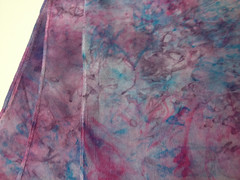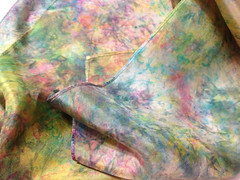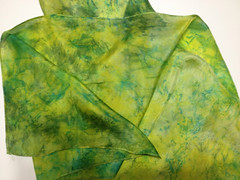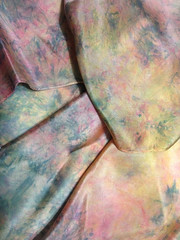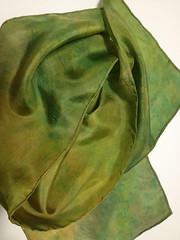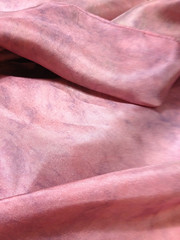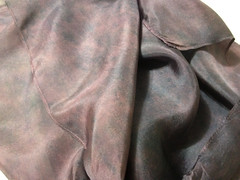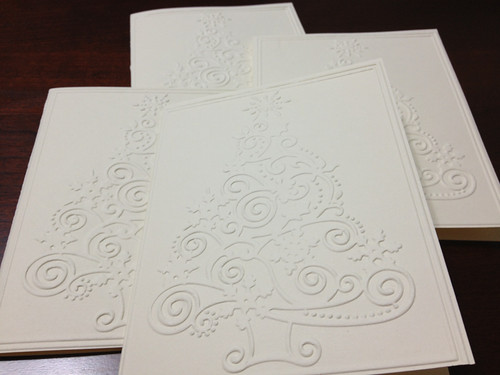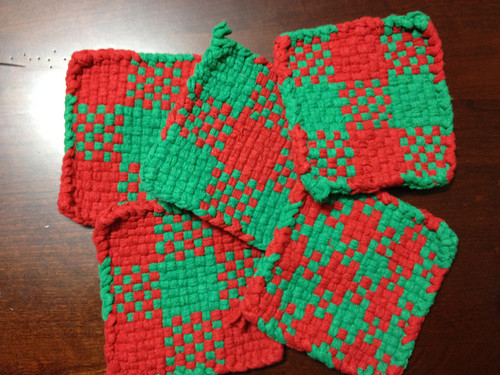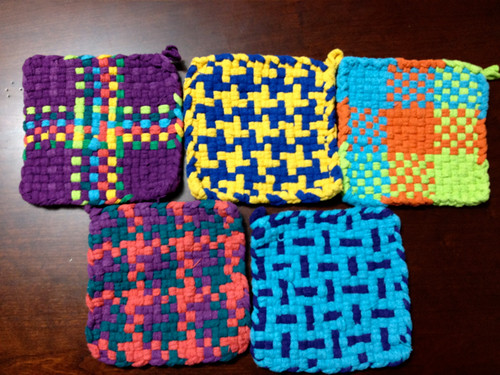I am absolutely in love with the Colorhue brand of dyes for protein fibers. What’s not to love about instant set dyes (no heat or time required) at affordable prices? Since I am going to be doing a tutorial later this month on how to dye scarves with this method and a full product review for another site, I’ll just show you some of the results I’ve gotten with this product. I’m utterly addicted!

The dyes come in a very concentrated form, sorry I haven’t taken a picture of them in their packaging. While the instructions say to use just a few drops per half cup of water, I found that to be very pale. I use one eyedropper of concentrate per ounce of distilled water. The first few I did used less than that, so you’ll see that some are more pastel. (Squirt bottles are not required, it depends on what sort of dye techniques you will be using, so far I have been doing what is known as “bread bag” dyeing, a low-water technique.)

Once you’ve mixed the solution (and there are no toxicity issues here!) you need something to dye. I had ordered a large batch of scarves from DharmaTrading.com — they have fantastic prices and a wide assortment of sizes. You can also buy the Colorhue Dye from them directly, although I had bought mine from a vendor at SAFF. I also bought a pillowcase because I often have flareups of dermatitis on my face and having a silk pillowcase is very soothing. Plus I did one experiment with some wool. I’ve since bought a lot more wool to dye but that will have to wait until after my move, alas. So first I started with some silk chiffon scarves that I bought at SAFF when I bought the dyes. These are very sheer so it is hard to see the true colors in the photos. Also this was when I was using one dropper of dye to two ounces of water, so the colors are less intense. 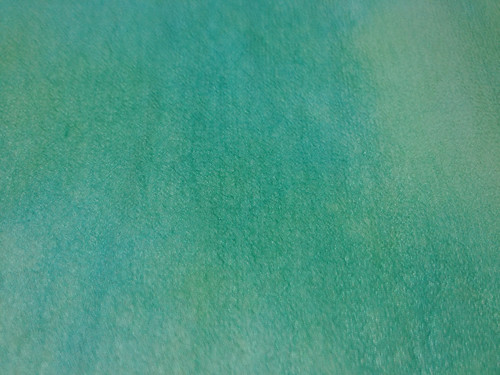

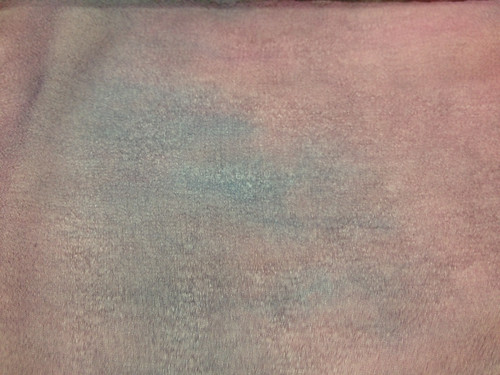
 Because these scarves were chiffon it was very hard to photograph them properly and it is hard to see the color distinctions. I have learned a bit more on how to make the variations in color and tone more obvious with more concentrated dyes and different base fabrics, but you’ll just have to trust me when I say these are a lot prettier in real life. Here’s the first batch all together:
Because these scarves were chiffon it was very hard to photograph them properly and it is hard to see the color distinctions. I have learned a bit more on how to make the variations in color and tone more obvious with more concentrated dyes and different base fabrics, but you’ll just have to trust me when I say these are a lot prettier in real life. Here’s the first batch all together:
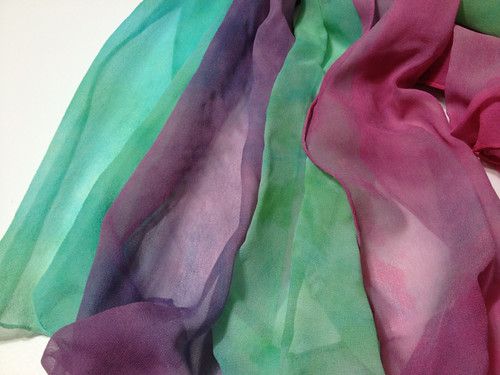
This image shows a bit more of the intensity, plus it’s a little easier to see the mottled shading. I dyed all of these twice as the colors were just too pale the first time so I kept layering more dye on them. This is why I doubled the concentration of my dyes the next time I mixed a batch. After these scarves I moved on to the pillow case: 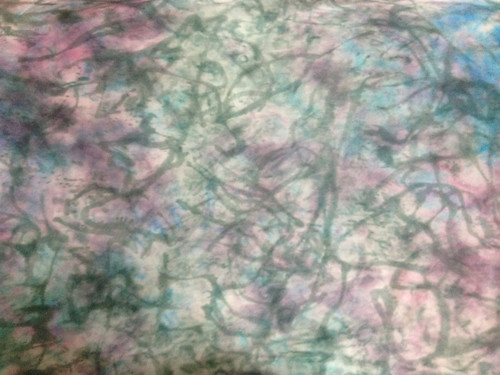 Again I had to keep going back and adding more dye, I still think the colors are far more pastel than I’d like (it really doesn’t match any of my bedding). In a final act of frustration I wrung out most of the water and them drizzled the black over the top. I love the effect the black had but I’m still debating redyeing the colored bits to be more intense. Or maybe just doing another pillowcase 🙂 At the same time I tried a bit of wool, like the kind used for applique and rug hooking. Again the colors were very pastel, due to the diluted dye mixture. I do sometimes need pastel so I will probably not redye this one, but will definitely use more concentrated solution in the future.
Again I had to keep going back and adding more dye, I still think the colors are far more pastel than I’d like (it really doesn’t match any of my bedding). In a final act of frustration I wrung out most of the water and them drizzled the black over the top. I love the effect the black had but I’m still debating redyeing the colored bits to be more intense. Or maybe just doing another pillowcase 🙂 At the same time I tried a bit of wool, like the kind used for applique and rug hooking. Again the colors were very pastel, due to the diluted dye mixture. I do sometimes need pastel so I will probably not redye this one, but will definitely use more concentrated solution in the future.  I did a few scarves in the habotai silk, but wound up redyeing most of them (as I will show you later). By this point I was fed up with the pastel shades and doubled the amount of dye in my mixtures. From this point I become a MUCH happier camper. Here are a slew of examples:
I did a few scarves in the habotai silk, but wound up redyeing most of them (as I will show you later). By this point I was fed up with the pastel shades and doubled the amount of dye in my mixtures. From this point I become a MUCH happier camper. Here are a slew of examples:
Unfortunately I still don’t have a light tent so not all of these photos are true to color. However I think they give you a decent idea of the range of palettes you can achieve with the basic Colorhue starter set. Remember how I said I’d re-dyed a few of the too-pale ones? Here they are, for comparison:
This one (first, pink) was OK, but didn’t go with my mother’s wardrobe, so I went to a more plum shade (second photo). The image doesn’t really do that one justice, the shinyess of the silk makes it look lighter than it really is.
So — these are my experiments so far. I can honestly say I am hooked. I’ve already got more wool and will be ordering more scarves as soon as payday comes around. Although I have no intention of selling crafts for personal profits (most of these have been given away already or are waiting to be given away), I am wondering if this might not be a good way to raise funds for my charity. If I *did* sell these scarves, what do you think would be a fair price for them? I know that handdyed silk usually fetches a decent amount, fair above what the supplies cost, but I’d like to make them affordable yet profitable enough to help the charity. Suggestions?
